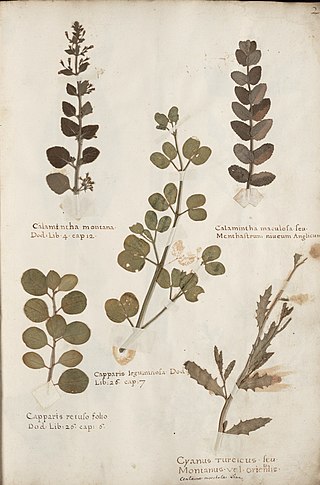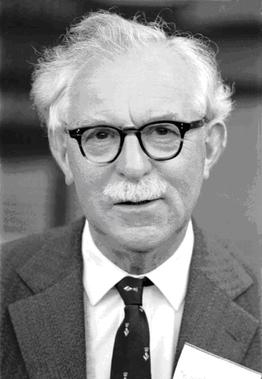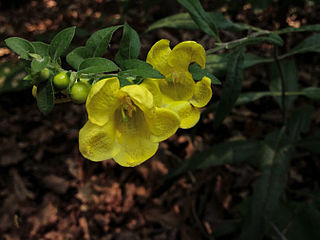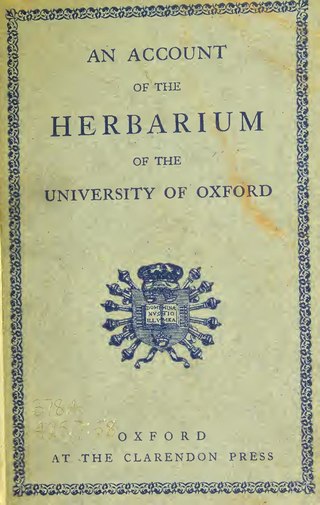

A vasculum or a botanical box is a stiff container used by botanists to keep field samples viable for transportation. The main purpose of the vasculum is to transport plants without crushing them and by maintaining a cool, humid environment.


A vasculum or a botanical box is a stiff container used by botanists to keep field samples viable for transportation. The main purpose of the vasculum is to transport plants without crushing them and by maintaining a cool, humid environment.
Vascula are cylinders typically made from tinned and sometimes lacquered iron, though wooden examples are known. The box was carried horizontally on a strap so that plant specimens lie flat and lined with moistened cloth. [1] Traditionally, British and American vascula were somewhat flat and valise-like with a single room, while continental examples were more cylindrical and often longer, sometimes with two separate compartments. [2] Access to the interior is through one (sometimes two) large lids in the side, allowing plants to be put in and taken out without bending or distorting them unnecessarily. This is particularly important with wildflowers, which are often fragile.
Some early 20th century specimen are made from sheet aluminium rather than tin, but otherwise follow the 19th century pattern. The exterior is usually left rough, or lacquered green.
The roots of the vasculum are lost in time, but may have evolved from the 17th century tin candle-box of similar construction. Linnaeus called it a vasculum dillenianum, from Latin vasculum – small container and dillenianum, referring to J.J. Dillenius, Linnaeus' friend and colleague at Oxford Botanic Garden. With rise of botany as a scientific field the mid 18th century, the vasculum became an indispensable part of the botanist's equipment. [3]
Together with the screw-down plant press, the vasculum was popularized in Britain by naturalist William Withering around 1770. [4] The shortened term "vasculum" appears to have become the common name applied to them around 1830. [2] Being a hallmark of field botany, vascula were in common use until World War II . With post-war emphasis on systematics rather than alpha taxonomy and new species often collected in far-away places, field botany and the use of vascula went into decline.
Aluminium vascula are still made and in use, though zipper bags and clear plastic folders are today cheaper and more common in use. [4]
The Vasculum was "An Illustrated Quarterly dealing primarily with the Natural History of Northumberland and Durham and the tracts immediately adjacent," from 1915 to 2015. [5]
The newsletter of the Society of Herbarium Curators is named "The Vasculum" since 2006. [6]

A herbarium is a collection of preserved plant specimens and associated data used for scientific study.

Sir James Edward Smith was an English botanist and founder of the Linnean Society.

The Royal Botanic Garden Edinburgh (RBGE) is a scientific centre for the study of plants, their diversity and conservation, as well as a popular tourist attraction. Founded in 1670 as a physic garden to grow medicinal plants, today it occupies four sites across Scotland—Edinburgh, Dawyck, Logan and Benmore—each with its own specialist collection. The RBGE's living collection consists of more than 13,302 plant species, whilst the herbarium contains in excess of 3 million preserved specimens.

Johann Müller was a Swiss botanist who was a specialist in lichens. He published under the name Johannes Müller Argoviensis to distinguish himself from other naturalists with similar names.

William Thomas Stearn was a British botanist. Born in Cambridge in 1911, he was largely self-educated and developed an early interest in books and natural history. His initial work experience was at a Cambridge bookshop, but he also had a position as an assistant in the university botany department. At the age of 29 he married Eldwyth Ruth Alford, who later became his collaborator, and he died in London in 2001.

Frederick Vernon Coville was an American botanist who participated in the Death Valley Expedition (1890-1891), was honorary curator of the United States National Herbarium (1893-1937), worked at then was Chief botanist of the United States Department of Agriculture (USDA), and was the first director of the United States National Arboretum. He made contribution to economic botany and helped shape American scientific policy of the time on plant and exploration research.

Rogers McVaugh was a research professor of botany and the UNC Herbarium's curator of Mexican plants. He was also Adjunct Research Scientist of the Hunt Institute in Carnegie Mellon University and a Professor Emeritus of botany in the University of Michigan, Ann Arbor.
Peter Geoffrey Taylor (1926–2011) was a British botanist who worked at Royal Botanic Gardens, Kew throughout his career in botany. Taylor was born in 1926 and joined the staff of the herbarium at Kew in 1948. He published his first new species, Utricularia pentadactyla, in 1954. In 1973, Taylor was appointed curator of the orchid division of the herbarium and, according to Kew, "under his direction, orchid taxonomy was revitalised and its horticultural contacts strengthened."

Edward (Ted) George Hudson Oliver, is a South African Botanist and author. He is an expert in heathers. He has discovered and named several species. Oliver is the recognized world authority on the subfamily Ericoideae.

Harriet Margaret Louisa BolusnéeKensit was a South African botanist and taxonomist, and the longtime curator of the Bolus Herbarium, from 1903. Bolus also has the legacy of authoring more land plant species than any other female scientist, in total naming 1,494 species.

Benjamin Lincoln Robinson was an American botanist.
John Scott Lennox Gilmour VMH FLS was a British botanist, curator of the Cambridge University Herbarium, and later director of Cambridge University Botanic Garden and Fellow of Clare College, Cambridge.

Aureolaria virginica, the downy yellow false foxglove or downy oak leach, is a perennial forb native to the eastern United States and Canada, which produces yellow flowers in summer.
William Grant Craib was a British botanist. Craib was Regius Professor of Botany at Aberdeen University and later worked at the Royal Botanic Gardens, Kew.
George Hill Mathewson Lawrence was an American botanist, writer and professor of botany who helped establish the 'Liberty Hyde Bailey Hortorium', the Hunt Botanical Library and the Huntia journal. He was also an avid book collector, including books on the history of Rhode Island, historic books and botanical art.

A plant press is a set of equipment used by botanists to flatten and dry field samples so that they can be easily stored. A professional plant press is made to the standard maximum size for biological specimens to be filed in a particular herbarium. A flower press is a similar device of no standard size that is used to make flat dried flowers for pressed flower craft.

Fielding-Druce Herbarium, part of the Department of Biology, University of Oxford, located on South Parks Road, in Oxford, England. A herbarium is a collection of herbarium sheets, with a dried pressed specimen of the botanic species, whether they were bound into a book by one dedicated individual, or have been amassed into huge collections. They are like plant ID cards. As paper was expensive, multiple specimens are normally mounted on one sheet. The 2 cores of the Herbarium collection, are bequeathed to the University from Henry Fielding (1805-1851) containing a non-British and Irish collection. It also covers most taxonomic groups and geographical areas. It is particularly rich in nineteenth century material from the Americas and south and south east Asia. The other core a British and Irish collection from George Claridge Druce (1850-1932) in 1932, this is particularly rich in specimens from Oxfordshire, Buckinghamshire and Berkshire. Other collections were added later.
Velva Elaine Rudd was an American botanist, specializing in tropical legumes. She worked as a curator at the Smithsonian Institution's National Museum of Natural History and also conducted research at the herbarium at California State University, Northridge.
Geraldine Anne Allen is a botanist, professor of biology, and herbarium curator at the University of Victoria in British Columbia, Canada. She obtained formal education at the University of British Columbia and Oregon State University, earning a Doctor of Philosophy degree in botany and plant pathology from the latter in 1981. During her career, she has authored or co-authored over 50 publications, including genera chapters for Flora of North America and the Jepson Manual. She also has authored several species of the Erythronium genus.

Emma Jane Cole was an American teacher, botanist, and curator, and the author of Grand Rapids Flora: A Catalogue of the Flowering Plants and Ferns Growing Without Cultivation in the Vicinity of Grand Rapids, Michigan. She was inducted into the Michigan Women's Hall of Fame in 2007.
with image